Remembering Bucyrus-Erie Company’s pull-type scrapers
Posted by Chris Graham on 1st November 2023
Keith Haddock reviews one of Bucyrus-Erie Company’s lesser-known products including its close ties with the International Harvester Company.
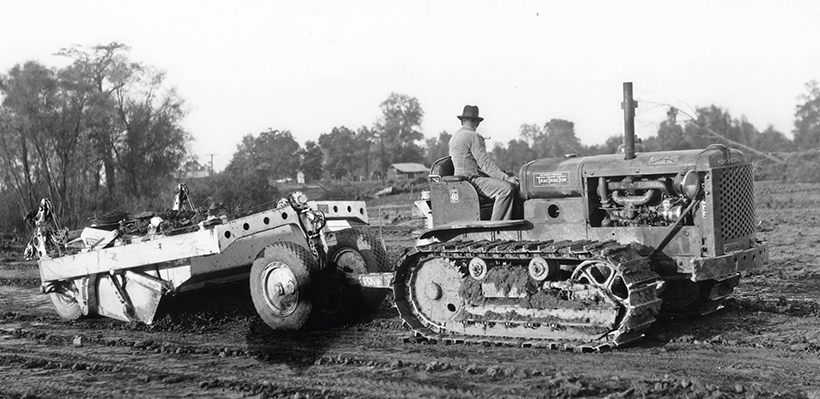
The Bucyrus-Erie Company’s first scrapers were four-wheel types operated by a single cable from a winch on the tractor. They were built in 4½-yard and 7-yard sizes.
It’s now exactly 70 years since the Bucyrus-Erie Company announced it was discontinuing manufacture of pull-type scrapers and all products related to its tractor equipment line. Long forgotten, or unknown by today’s earthmoving contractors, these machines and attachments are still cherished by equipment enthusiasts. More famous for its cranes, excavators, and giant walking draglines, Bucyrus-Erie (B-E) announced in 1935 it would commence building a line of pull-type scrapers, followed by other tractor equipment including dozer blades, loader attachments, winches, pull-type rippers and rollers.
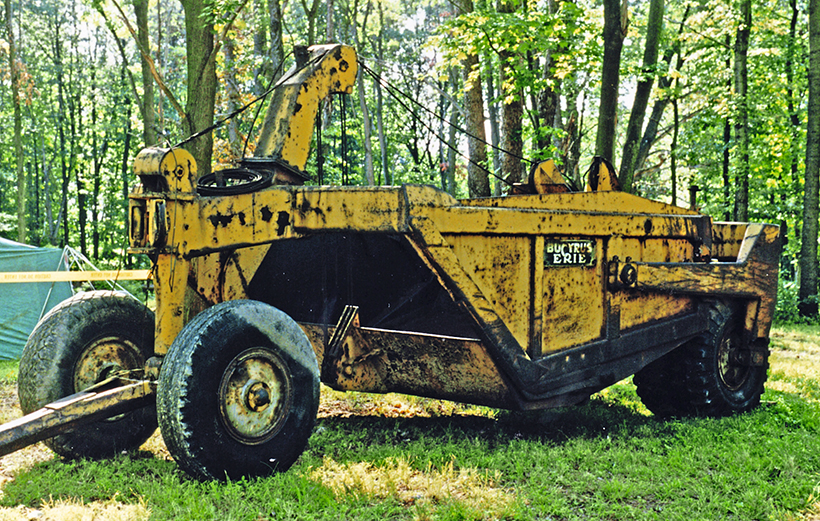
This is the model S-112 rated at 12½ cubic yards heaped capacity, one of the early S-series Bucyrus-Erie scrapers. This one was on display at an annual convention of the Historical Construction Equipment Association.
During the 1930s, RG LeTourneau and other American companies had already established a sizeable scraper market, and B-E felt they were losing out on some shovel sales to the new method of earthmoving. In addition, construction equipment manufacturers were still reeling from the Great Depression and, in the case of B-E, their main factories were still operating at about one-third capacity.
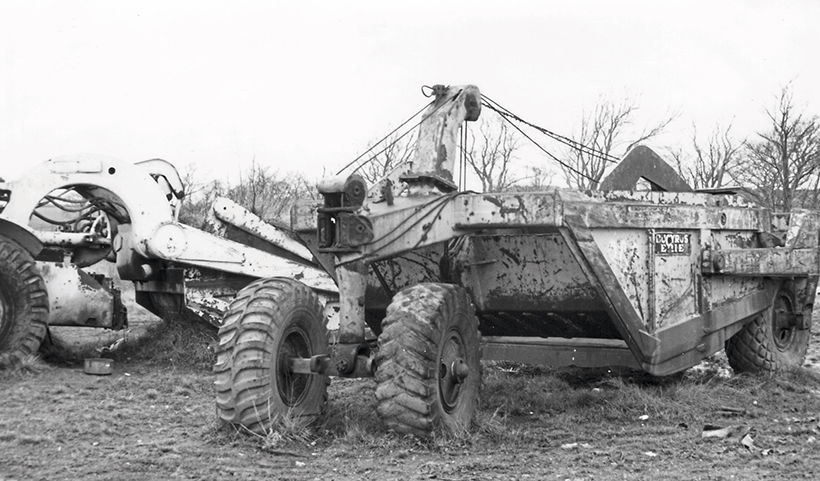
Bucyrus-Erie’s successful S-series scrapers included this S-90 built in 1941, photographed at Avonbridge, West Lothian, Scotland in 1974.
B-E learned that International Harvester was expanding its range of crawler tractors, and were looking for an exclusive supplier of tractor equipment to match their tractors. In those days, it was usual for tractor manufacturers to have other companies make equipment to use with their tractors, mostly under exclusive arrangements. Tractor manufacturers could not afford to take up valuable shop space for metal fabrication. Instead, they allied themselves with tractor attachment builders to supply equipment exclusively for them. Consequently, International and B-E established an arrangement in 1935 to benefit both companies: B-E would supply tractor equipment for use with International’s tractors.
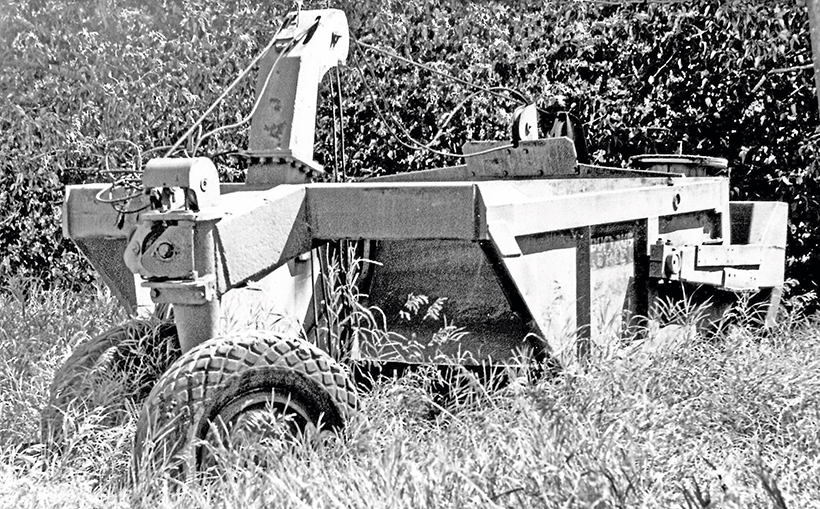
The S-series scrapers raised their bowls from the rear as shown on this model S-67 with 7½ cubic yards heaped capacity.
Bucyrus-Erie’s first scraper was a four-wheel machine, operated by a single cable from a drum winch on the tractor. The single rope worked all three functions of bowl, apron, and load dumping through a complicated system of sheaves and linkages. Two sizes were offered without model numbers, and simply referred to as 4½ -yard and 7-yard models. The convenience of operation from a single drum winch was negated by high maintenance of the complicated mechanism and somewhat restricted control during loading. The machines obtained only limited success, and a new improved design soon followed.
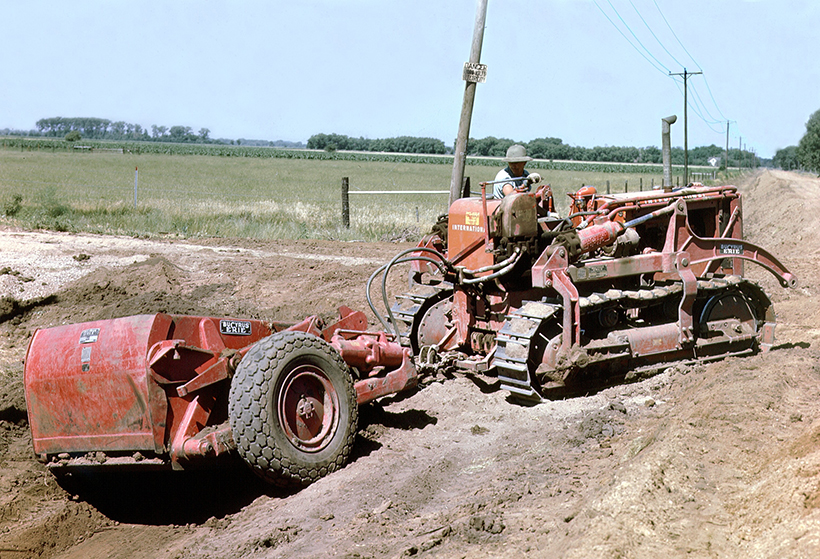
Bucyrus-Erie’s two-wheel scrapers were built from 1937 to 1951. This model G-38 carried 4½ cubic yards.
The second series of pull-type scrapers from Bucyrus-Erie, the S-series, was still a radical design but proved very durable, remaining in production for over 12 years. The initial range consisted of the S-45, S-67, S-90, S-112, and S-152 with heaped capacities listed as 5, 7½, 10, 12½ and 17 cubic yards respectively. They were operated by two cables from a two-drum winch, but the bowl was lifted from the rear instead of the more usual front lift arrangement. And to dump the load, the pivoted scraper floor was hoisted from the rear rather than the usual slide-out (ejector) design.

The B-113 with 14 yards heaped capacity appeared in 1951 as one of Bucyrus-Erie’s B-series scrapers featuring the more conventional front-lifting bowl.
In 1937 B-E introduced two models of two-wheel scrapers: the H-44 and H-74 of 5 and 8 cubic yards heaped capacity. These were rear-dumping and hydraulically operated through hose connections to a hydraulic pump and valve system on the tractor. The end of World War II brought upgraded replacement models: the G-38 and G-58 carried 4½ and 6 heaped cubic yards respectively. By 1951, B-E discontinued its two-wheel scrapers.
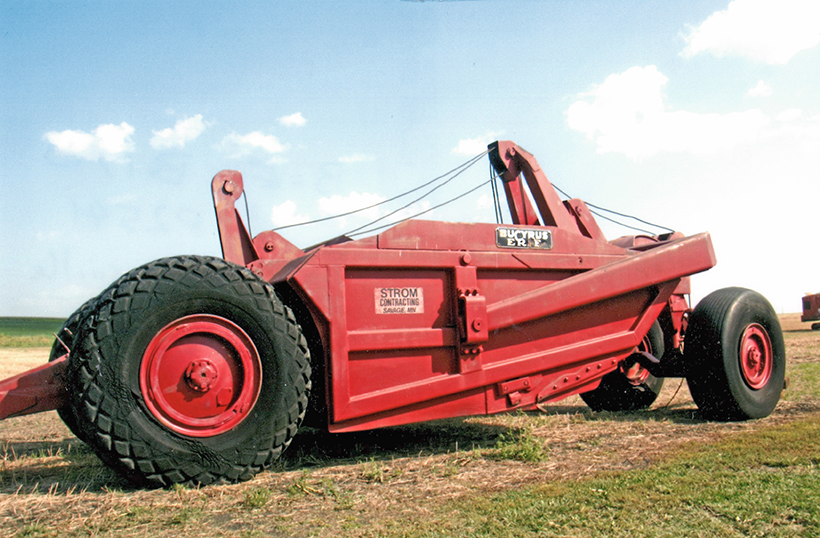
The mid-size Bucyrus-Erie scraper B-170 rated at 19 cubic yards was introduced in 1949 as part of the modernised B-series scrapers.
In 1948 B-E announced upgrades for the four smaller S-series scrapers. Improvements included a curved ‘goose neck,’ improved straight-line cable reeving, adjustable-height push bumper and double-curved cutting edge. Capacities remained the same but models were re-numbered S-46, S-68, S-91 and S-113. The S-152 remained as before.
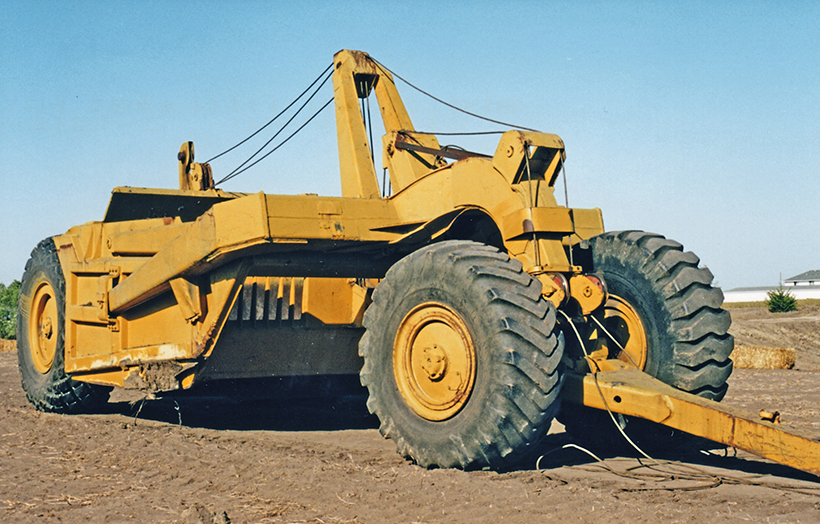
In 1952, the B170A was upgraded from the former B-170, making it a more suitable match for the big International TD-24 crawler tractor. Heaped capacity increased from 19 to 21 cubic yards.
Also in 1948, the B-250, the first of the B-series scrapers appeared, featuring the more conventional method of lifting the bowl from the front. This was a new large scraper designed to match the International TD-24 crawler tractor, recently introduced as the world’s most powerful crawler. The B-250 was rated at 22 cubic yards struck capacity and 27½ yards heaped. The cutting edge was 10 feet wide and overall empty weight was 42,700 pounds. Since International’s tractors’ standard colour was red, Bucyrus scrapers were also painted red to comply, and fleets of TD-24 tractors pulling B-250 scrapers became known as the “Big Red Teams”.
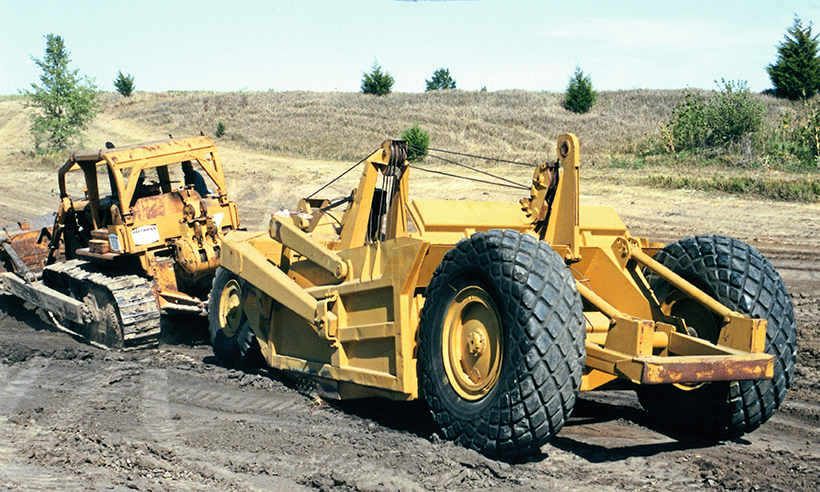
Another view of the B170A scraper showing cable arrangements for bowl and apron lift.
Over the next few years, three more B-series scraper models were added to gradually replace the former S-series. The B-170 (19 yards heaped) appeared in 1949, and the B-113 (14 yards heaped) replaced the S-113 in 1951. A 10-yard heaped model, the B-91, rounded out the lower end of the updated scraper range. In 1952, the B-170 was upgraded to the B-170A making it “suitable for use with the exceptional power and speed of the TD-24,” and advertised as having 10% greater weight, larger tyres, and capacity upped to 21 cubic yards.
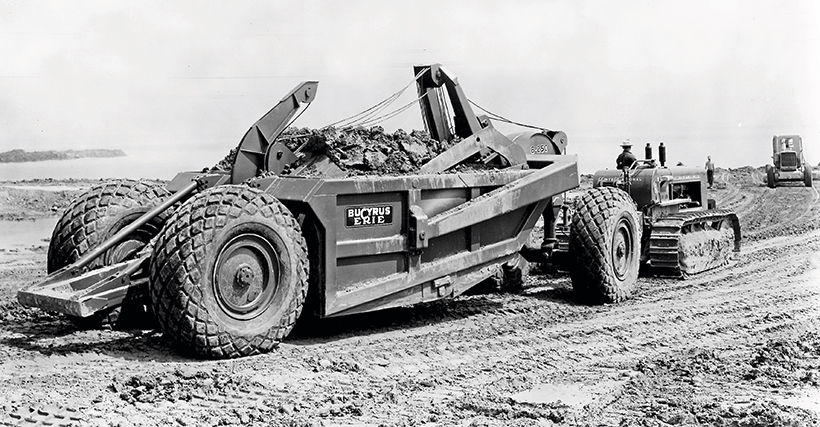
The largest Bucyrus-Erie scraper was the B-250 of 27½ yards heaped capacity. Launched in 1948, it was the first of the company’s modern B-series scrapers.
The B-Series scrapers saw Bucyrus-Erie through to the end of its association with tractor equipment. The major factor contributing to B-E’s withdrawal from tractor equipment manufacture was International Harvester’s announcement in 1953 that it was about to follow the lead taken by Caterpillar and commence building its own tractor equipment. To boost this effort, International Harvester that same year purchased the Heil Company of Milwaukee with its line of pull-type and motor scrapers. These models became the basis of all future scrapers produced by International Harvester.
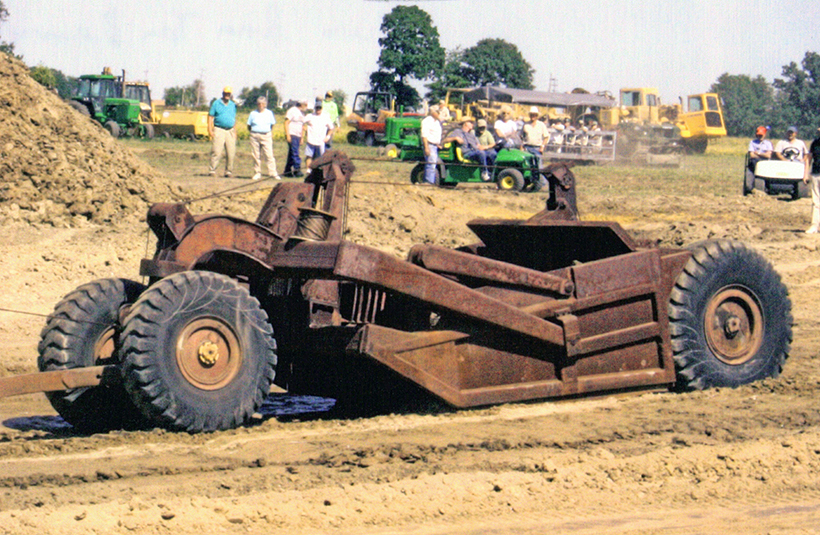
A Bucyrus-Erie B-250 scraper being put through its paces at a Historical Construction Equipment Association convention in Bowling Green, Ohio.
Following International’s announcement, Bucyrus-Erie began to phase out tractor products and sell remaining inventory. Although B-E had enjoyed some 20 profitable years as a tractor-allied equipment builder, the loss of these products only marginally affected the company. At that time, sales of its cranes, excavators and walking draglines were increasing, and acquisitions of other product lines were on the horizon.
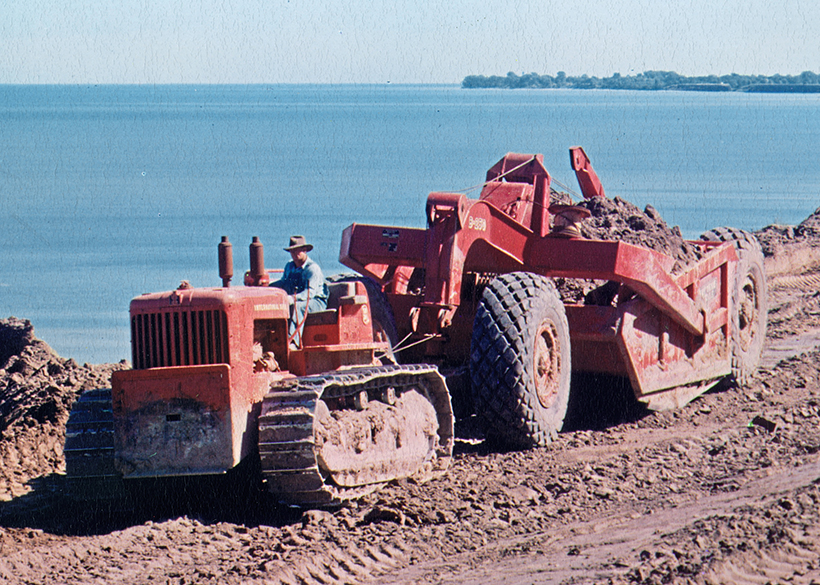
A member of the “Big Red Team” at work in sunny California. An International TD-24 tractor pulls a Bucyrus-Erie B-250 scraper,
This feature comes from the latest issue of Old Glory, and you can get a money-saving subscription to this magazine simply by clicking HERE
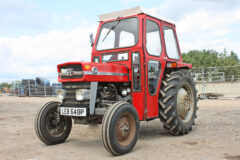
Previous Post
Massey Ferguson 135 Quick-Detach cab

Next Post
Great Christmas gift ideas from Kelsey Media!



